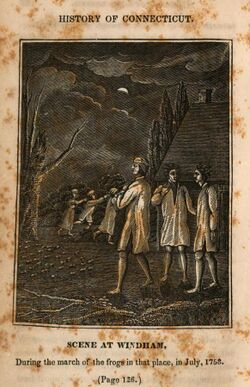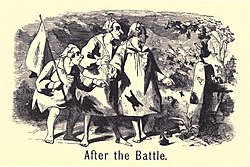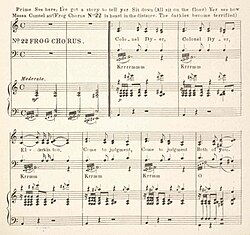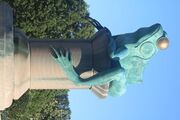Biology:Battle of the Frogs
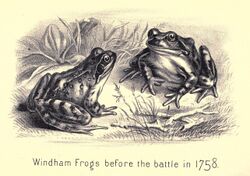 Illustration from The story of Bacchus, and Centennial souvenir | |
| Date | June or July of 1754[lower-alpha 1] |
|---|---|
| Venue | Frog Pond (then Follett's Pond) |
| Location | near Windham, Connecticut Colony |
| Coordinates | [ ⚑ ] : 41°42′15.8″N 72°8′10.2″W / 41.704389°N 72.136167°W |
| Also known as | Windham Frog Fight Windham Frog Fright |
| Type | Local legend |
| Cause | Possibly drought or a lekking |
| Participants | Townspeople of Windham, bullfrogs |
| Deaths | Hundreds if not thousands of bullfrogs |
The Battle of the Frogs[lower-alpha 2] is a local legend concerning an incident in the Connecticut Colony town of Windham in 1754.[lower-alpha 1]
According to the legend, on a summer night, residents of the town were awakened by a mysterious loud noise of which they could not identify the source. Being the French and Indian War, the townspeople were wary of a possible attack from the French or Native Americans. The odd noise seemed to emanate from above and some people heard words in noise, thought to be the demands of the supposed attacking force or threats against prominent men in their community. This led them to panic and assume that Windham was under attack, some of them mistaking the croaks for shouted words or the beating of drums. A scouting party was sent out to investigate or negotiate. In the morning, hundreds of dead bullfrogs were found along the shore of a millpond east of the village. The loud croaking was largely attributed to a battle between the frogs, a lekking involving fighting over diminished territory in a drought-stricken pond.
The "battle" that the Windhamites had with the frogs became a running joke in the region. Windham then embraced the frog as an emblem for the community, adopting a town seal with a frog and featuring frogs on currency from Windham Bank in the 19th century. Ballads and an opera were written about the Battle of the Frogs. The Thread City Crossing in Willimantic is colloquially known as the "Frog Bridge" for the four enormous copper frogs perched at each corner.
The "battle"
Many of the accounts of the Battle of the Frogs are quasi-historical, often embellishing or exaggerating aspects of the incident. Some accounts relate that there had been a drought the summer of the incident that had drastically reduced the water level of the millpond.
On a summer night in either June or July of 1754,[lower-alpha 1] the townspeople of Windham were awakened by a mysterious cacophonous noise. They were unable to identify the source of the sound and, thinking that the village was under attack, they sent out a scouting party to determine the complement of their supposed foes. The origin of the sound was determined to be coming from a mill pond east of the village where a large number of bullfrogs (Lithobates catesbeianus) were living. The corpses of the bullfrogs were found the next day.
The gruesome battle was actually a large-scale die-off of frogs in a millpond known as Frog Pond. In 1754, Windham was experiencing a severe drought and the French and Indian War had recently broken out. An attack from French and native forces was also expected from Canada. One night, in June, the frogs began to attack each other over the last remaining water. The resulting noise was so great that the townspeople thought that it was the attack already happening. Many took to arms. This led to mass hysteria of sorts. Numerous people became convinced that Armageddon was upon them. Some sources claim that the names "Dyer" and "Elderkin" were heard, the names of two influential lawyers and colonels. Other sources say that the people thought they were Native Americans saying "gin" and "rum." Townsfolk ran into the streets, some with guns and knives. Those who were armed mounted a hill to see the landscape around them. In the morning, the colonists found the cause of the noise. Hundreds of dead and dying bullfrogs lay in the last remaining parts of the pond.
Colonel Eliphalet Dyer and Colonel Jedediah Elderkin were both Yale graduates and prominent lawyers who had set up offices in Windham.[4]
Aftermath
While no newspapers seem to have written up the incident, news of the Windham community's "battle" with the frogs spread throughout the Connecticut Colony. The earliest extant document to mention the incident was a July 1754 letter from Abel Stiles to his nephew Ezra Stiles, who later became president of Yale College. The elder Stiles quoted a section of Ovid's Metamorphoses referring to the Lycian peasants who had been transformed into frogs before mentioning Windham and the bullfrogs.[3] Windham became the laughingstock of the colonies.[5] The people of Windham were ridiculed in the colonies. Apparently, residents of Windham could not go very far from home without hearing something about bullfrogs.[6] Ballads were written about the incident while "rhyme and dogerel circulated freely".[7] He wrote that "Long and obstinately [fought] was the contest, and many thousands of combatants were found dead on both sides of the ditch the next morning."[2]
The story persisted over the years and spread to other colonies. The tale undoubtedly followed Eliphalet Dyer throughout his career. Once, upon his arrival at Congress, he was met with laughter. Unbeknownst to him, a dead bullfrog had been dangling from the back of his carriage.[8] David Hillhouse, writing of his first experience attending an opera in New York in 1826, was initially displeased with the "gibberish and squall, reminding me forcibly of the—battle of the frogs at Windham in ancient days".[9]
The Windham community embraced the frog as an emblem. The event has become memorialized as a part of the town's folklore. The pond, formerly known as Follett's Pond, was renamed Frog Pond. A town seal including the silhouette of a bullfrog was adopted.[4]
According to folklorist Richard Dorson, Windham's adoption of the frog as a symbol was a form of boosterism with the town turning the tale to their advantage and distinguishing themselves from other communities. Windham produced postcards depicting gigantic frogs or "worthies in nightdress" conversing with frogs. Dorson says that the Windham Public Library distributes a booklet with one of the ballads devoted to the battle and "places book plates with the frog emblem in its volumes".[10]
A paper read by Thomas Snell Weaver to the Connecticut Historical Society in 1897 asserted that the Dyer referred to in accounts of the "Dyer" name heard by the townspeople actually referred to Colonel Thomas Dyer, and not his son Eliphalet.[11]
Versions of the tale
Account of Samuel Peters
The most repeated account of the Battle of the Frogs may be that of the Reverend Samuel Peters, a Loyalist who wrote an exaggerated account of the incident in his largely counterfactual 1787 book History of Connecticut. Peters, a graduate of Yale University from Windham's neighbor Hebron, had been disgraced as a Loyalist following the Revolution and was forced to flee to England where he published his embittered history of Connecticut. His book was nicknamed The Lying History in Connecticut.[3] In addition to naming one of his ancestors as the founder of Yale, Peters invented animals, claimed that a river was "solid", and fabricated Blue Laws.[12]
Elements from Peters' account of the Battle of the Frogs were included in later ballads and retellings. In his version, the frogs were located some five miles from Windham in "an artificial pond three miles square." He writes that the frogs, having found the water dried up, hopped their way towards the Willimantic River and that they "filled a road forty yards wide for four miles in length," entered Windham around midnight, and were several hours in their passage. In his account, the residents of Windham fled naked from their beds with "worse shrieking than that of the frogs," fearing an earthquake or "dissolution of nature." Peters relates that the men retreated a half mile and upon their return heard from the "enemy's camp" voices uttering words "Wight, Hilderken, Dier, Tete." They only discovered that their attackers were frogs after three men were sent to negotiate.[12]
According to a review of his account in American Notes and Queries, his prejudices "led him to connive at the dismemberment of Connecticut." Peters, who had Tory sympathies, was forced to leave the country in 1774. The Notes and Queries review, noting that Peters exaggerated the size of Frog Pond and its distance from town, also observed that a migration of frogs would likely have sought out the Shetucket River, which was closer than the Willimantic.[12]
Ballads
At least three ballads were written about the Battle of the Frogs. Lebanon residents Stephen and Ebenezer Tilden are credited as authors of the 1840s ballad "Lawyers and Bull-Frogs". The ballad is introduced as "a true relation of a strange battle between some Lawyers and Bull-Frogs, set forth in a new song written by a jolly farmer of New England." The ballad's closing stanza says "Lawyers, I say, now from this day, be honest in your dealing. And never more increase your store, while you the poor are killing."[12][3] There was another ballad called "The Frogs of Windham" and a third entitled "The Bull-Frog Fright: A Ballad of the Olden Time" had forty-four stanzas and was published in 1851.[12]
Account of William Lawton Weaver
In 1857, William Lawton Weaver compiled the 48-page booklet The Battle of the frogs, at Windham, 1758: with various accounts and three of the most popular ballads on the subject. It was published by James Walden in Willimantic. In his introduction, Weaver offers his own interpretation of the events.[8]
Account of Sinda
Ellen Douglas Larned, in the second volume of her 1880 History of Windham County, Connecticut, relays the account of Sinda, "wife of Jack, body servant to Colonel Eliphalet Dyer":
| “ | Well it was in June, I think, and the weather was very hot, and Master had drawn off the Pond to fix the dam. When he came home he did not think of nothin'—by and by when it became cool there began to be a rumble, rumble, rumble in the air, and it grew louder and louder and louder, and seemed to be like drums beating in the air. Well, it was in the old French War, when our men had gone to Belle Isle or Canada to fight the French and Indians, and some guessed it was the Injuns having a powwow or war dance on Chewink Plain, and we should all be killed in the morning. But Master and Colonel Elderkin and Mr. Gray mounted their horses and rode to the top of Mullein Hill, and as the pond was a little over there beyond they found out what it was—and the scare was over. Master said he supposed the frogs fought each other for the next day there were thousands of them dead. They croaked some the next night but nothing so bad. | ” |
| — Sinda, History of Windham County, Connecticut: 1760-1880.[13] | ||
Account of Abner Follett, Jr.
William Lawton Weaver wrote that the account of Abner Follett, Jr. was the most credible. The Follett family had owned the pond during the incident and his father, Abner Follett, Sr. had memory of the incident, though he was young. Weaver wrote that "to those who know Mr. F., it is unnecessary to say that nothing exaggerated or savoring of romance would be stated or entertained by him." Follett disputed that there had been a drought or that the pond had dried up. He said that while there had not been a migration of frogs from the pond, their outcry was both thunderlike and extraordinary. Those who lived closest to the ruckus reported feeling their beds vibrate underneath them. Follett said that "the whole thing was simply the anvil chorus of a happy family of frogs".[14]
Other accounts
Historian Jeptha Root Simms wrote about the Battle of the Frogs in his 1846 book The American Spy, Or, Freedoms Early Sacrifice. In Simms' retelling of the tale, after Colonel Dyer ascended the hill to the east of Windham, "his courage failed him, and when he would have advanced eastward, his knees smote their fellows with dangerous collision". Simms compared the fight between the frogs to that of the Kilkenny cats.[15]
"Shepherd Tom" Hazard also wrote of the Battle of the Frogs. His recounting of the tale was included in Jonnycake Papers, his 1880 folk tale collection.[16]
Explanations for the frog behavior
Most of the versions of the story conclude that a drought caused the pond to dry up[7] and that the bullfrogs fought each other, leading to many deaths. Other explanations that were raised included an outbreak of disease.[17]
Herpetologist Susan Z. Herrick, who grew up in Windham and has spent over 3,000 hours making field recordings of wild bullfrogs, has speculated that the bullfrogs were making advertisement calls. The bullfrogs, confronted with a shrinking shoreline and being pushed together as they lost physical territory, may have shifted their mating strategy and started lekking in a situation Herrick compared to a mosh pit.[18] With so many males in a small pond, Herrick speculates that "all the males gave up on having any territory at all and focused strictly on at least getting a female. With no coordination of calls, it must have been a God-awful noise, and I think this is what the villagers heard."[19]
At a meeting of the Massachusetts Historical Society in 1925, Allan Forbes reported on the encampments of soldiers from the French Army during the French and Indian War. One such encampment was near Windham and during his tour of the area, Forbes was told by residents that the Frenchmen had begun hunting frogs after they pitched their tents. He concluded from the stories he was told that they didn't have much else to eat. One person suggested that the legend of the mass migration of frogs from the pond was due to their trying to escape from the soldiers.[20]
Legacy
The Battle of the Frogs is celebrated in many ways including as a song, bullfrogs as symbols on their heraldic devices and coat of arms.[8] The original plans for the Willimantic town hall, which was constructed in the late 19th century, called for the entrance to be guarded by two frogs.[21] During a 1902 visit by President Theodore Roosevelt, a banner commemorating the Battle of the Frogs was displayed.[22] Sometime prior to 1919, an archway over the road from Willimantic to Windham included two large bullfrogs dressed in green and white uniforms.[23]
Willimantic, Connecticut has a bridge with statues of frogs commemorating the event.[1]
High school class rings are also sometimes embossed with frogs.[21] A local high school newspaper is named Croaking and police shoulder patches incorporate the town seal, which includes a frog in its design. Historic recitations of the tale have been given in the village green of the Windham Center Historic District, especially on significant anniversaries of the battle.[24] In 2005, the Windham Area Arts Collaborative commissioned local artists to decorate around a dozen copies of the frog sculptures from the Frog Bridge.[25] Willimantic has hosted frog jumping contests.[26]
Banknotes depicting frogs
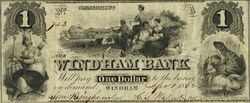
The Windham Bank, chartered in 1832, produced banknotes that included a frog vignette. The vignette, featured prominently in the lower right of the notes, depicts a frog sitting atop another overturned, and dead, frog. The bank included the vignette in their $1, $2, $3, $5 and $10 denominations until the 1870s.[27][28]
The Frogs of Windham opera
Nason W. Leavitt, the former owner of the Willimantic Enterprise newspaper, and his son Burton wrote the comic opera The Frogs of Windham in the 1880s.[5] It was published and copyrighted in 1891.[22]
The operetta includes a romantic subplot where Colonel Dyer tries to marry his daughter to a "weak-minded English youth." A farmer boy smitten with the daughter plots to have the English lord captured by Mohegan Indians.[22] The show's "Frog Ballet" was reported to have "caused much merriment"[29] and the drinking song "Good Old Windham Flip" honored a local alcoholic concoction.[5] The operetta contains numerous ethnic stereotypes, including an "Injun" war dance, a German character named Lim Burger, African American characters who are enslaved by Dyer, dancing gypsies, and an English lord with a speech disorder. In the opera, the frogs are only introduced in the last half of the third and final act as a "mysterious noise". Colonel Dyer is convinced by a parson that the noise is God's way of telling him that he shouldn't stop his daughter from marrying the person she loves. One of Dyer's captains then arrives and announces that the noise was merely a "throng of combative frogs". The Frogs of Windham was performed throughout Connecticut in the late 1800s and early 1900s. The operetta's 82-page piano score is held by the Library of Congress.[5]
An updated production of The Frogs of Windham was prepared for the sesquicentennial of the incorporation of Willimantic in 1983. The Sesquicentennial Fine Arts Committee used state and city grants to finance the set and costumes. Kramer Middle School teacher Robert Brouillard called the operetta "a director's nightmare," noting its amateurish libretto and comparing it to the fictional musical Springtime for Hitler. Brouillard rewrote the story, which was "riddled with racial and ethnic epithets." The production included antique muskets as props and featured the Windham Community Orchestra as well as the choreography of Windham Ballet artistic director Barbara Johnson. University of Connecticut music professor David Maker provided orchestration that the score had previously lacked.[22] The Windham Theatre Guild performed the work again in 1992.[5]
Frog Bridge
Willimantic's Thread City Crossing, also known as the Frog Bridge, was completed in 2000 and crosses the Willimantic River. The bridge features four 11-foot (3.4 m) tall copper frogs atop giant concrete spools on either side of the bridge. Designed by artist Leo Jensen, the lazily perched frogs pay homage to the Battle of the Frogs and are named Manny, Willy, Windy and Swifty.[30] William H. Grover, who was asked to draw up designs for the bridge, initially produced a Victorian theme with spools to represent Willimantic having been the home of the American Thread Company. Windham Planning Commission chair David E. Philips, who wrote the 1984 book Legendary Connecticut, suggested incorporating frogs into the design. Willimantic residents also offered suggestions for the bridge. One returned from Serbia with a travel brochure for Dragon Bridge, which has dragons on either end that are supposed to wag their tails when virgins walk over it, according to local legend. Responding to the suggestion, Margaret P. Reich, executive director of the Windham Regional Planning Agency, said "we'd like to create a similar urban legend, but with frogs—and probably not involving virgins."[31]
Notes
- ↑ 1.0 1.1 1.2 Many accounts give 1758 as the year of the Battle of the Frogs. John Warner Barber wrote in the 1836 book Connecticut Historic Collections that the incident had occurred in July 1758.[2] A letter written on July 9, 1754, to Ezra Stiles makes mention of the incident.[3]
- ↑ The incident has also been referred to as the Windham Frog Fight and the Windham Frog Fright.[1]
References
- ↑ 1.0 1.1 Hoberman, Michael (June 8, 2018). "Bridge Ornaments Help Tell the Legend of the Windham Frog Fight" (in en). Connecticut History. https://connecticuthistory.org/bridge-ornaments-help-tell-the-legend-of-the-windham-frog-fight/.
- ↑ 2.0 2.1 D'Agostino, Thomas; Nicholson, Arlene (2011). "Frog Pond and Bridge" (in en). Connecticut Ghost Stories and Legends. Arcadia Publishing. ISBN 978-1-61423-793-8. https://books.google.com/books?id=lmd_CQAAQBAJ&pg=PT114.
- ↑ 3.0 3.1 3.2 3.3 "Lawyers and bullfrogs". American Antiquarian Society. https://www.americanantiquarian.org/thomasballads/items/show/145. "If the late tragical tidings from Windham deserve credits, as doubtless it doth, it will then concern the gentlemen of your jurisperitian order to be fortified against the dreadfull croaks of the Tauranaon Legions... but pray whence it is that the croaking of a Bull Frogg should so Balshazzarise a Lawyer?—& how Dyarful ye alarm made by these audacious longwinded Croakers!"
- ↑ 4.0 4.1 Swift, Ruth (December 10, 1975). "A History of the Village And The First Congregational Church Windham, Connecticut". pp. 15–16. http://static1.squarespace.com/static/5218f267e4b0564f9832e25a/t/527c3958e4b0a7e07fb09456/1383872856919/A+History+of+the+Village+&+1st+Congregational+Church.pdf.
- ↑ 5.0 5.1 5.2 5.3 5.4 Padua, Pat (July 21, 2016). "Nocturnal Sounds Inspired the Comic Opera The Frogs of Windham". In The Muse (Library of Congress). https://blogs.loc.gov/music/2016/07/nocturnal-sounds-inspired-the-comic-opera-the-frogs-of-windham/.
- ↑ Payne, Brigham, et al. "The Story of Bacchus, and Centennial Souvenir". Hartford, Conn., A. E. Brooks, 1876.
- ↑ 7.0 7.1 Bayles, Richard (1889). "The Battle of the Frogs". History of Windham County, Connecticut. http://www.ctgenweb.org/county/cowindham/records/other/windhamlegendsbayles.htm. "A mile away to the east of the town was a marshy pond, the home of thousands of batrachians, large greenbackers and mottled little peepers, such as often make night hideous. A drought had reduced their pond to a narrow rill, and for this the poor thirsty creatures had fought and died like Greeks at the pass of Thermopylae."
- ↑ 8.0 8.1 8.2 Weaver, William L. The Battle of the Frogs, at Windham, 1758: With Various Accounts and Three of the Most Popular Ballads on the Subject. Willimantic, CT: James Walden, 1857.
- ↑ Gassan, Richard H. (2010). "Tourists and the City: New York's First Tourist Era, 1820–1840". Winterthur Portfolio 44 (2/3): 235. doi:10.1086/653731. ISSN 0084-0416. https://www.jstor.org/stable/10.1086/653731.
- ↑ Dorson, Richard M. (1978). "Editor's Comment: Boosterism in American Folklore". Journal of the Folklore Institute 15 (2): 181–182. ISSN 0015-5934. https://www.jstor.org/stable/3814093.
- ↑ "City and Vicinity: Col. Eliphalet Dyer". The Hartford Daily Courant: p. 6. October 6, 1897.
- ↑ 12.0 12.1 12.2 12.3 12.4 F. T. C. (August 30, 1890). "The Frogs of Windham (Vol. v, p. 171). - A Legend of the French-Indian War." (in en). American Notes and Queries (W.S. and H.C. Walsh): 209–211. https://books.google.com/books?id=dfk3AQAAMAAJ&dq=%22Windham%20Frog%20Fight%20%22&pg=PA210. Retrieved August 12, 2020.
- ↑ Larned, Ellen Douglas (1880) (in en). History of Windham County, Connecticut: 1760-1880, Volume 2. p. 592. https://books.google.com/books?id=uN0TAAAAYAAJ&q=%22battle%20of%20the%20frogs%22%20windham&pg=PA592. Retrieved January 28, 2021.
- ↑ Noyes, C. Russell (July 6, 1941). "Early Windham's Historic Battle of the Frogs". The Hartford Courant Magazine: p. 9.
- ↑ Simms, Jeptha Root (1857) (in en). The American Spy, Or, Freedoms Early Sacrifice: A Tale of the Revolution, Founded on Fact. J. Munsell. p. 20. https://books.google.com.ar/books?id=vbk4AQAAMAAJ&ots=yBR98aROGq&dq=%22Battle%20of%20the%20Frogs%22%20windham&lr&pg=PA20#v=onepage&q&f=false.
- ↑ Dorson, Richard M. (1945). "The Jonny-Cake Papers". The Journal of American Folklore 58 (228): 111. doi:10.2307/535499. ISSN 0021-8715. https://www.jstor.org/stable/535499.
- ↑ "The Great Windham Frog Fight: A History Through Documents". Windham Textile and History Museum. https://millmuseum.org/windham-frog-fight/.
- ↑ "Why a small New England town celebrates its heritage by honoring frogs" (in en-us). PBS NewsHour. August 3, 2023. https://www.pbs.org/newshour/show/why-a-small-new-england-town-celebrates-its-heritage-by-honoring-frogs.
- ↑ Wadsworth, Kimberly (February 3, 2014). "A Connecticut Town's Tribute to a Bullfrog Battle" (in en). Atlas Obscura. https://www.atlasobscura.com/articles/a-connecticut-town-s-tribute-to-a-bullfrog-battle.
- ↑ Washburn, Charles G. (1924). "Annual Meeting, April, 1925. Report of the Council; Report of the Treasurer; Report of the Librarian; Officers of the Society; French Marches and Camp Sites; Charles Francis Adams; Ten Years of the Photostat; Photostat Americana; Woodman Letters; Henry Cabot Lodge". Proceedings of the Massachusetts Historical Society 58: 271. ISSN 0076-4981. https://www.jstor.org/stable/25080172.
- ↑ 21.0 21.1 Swift, Deborah Petersen (November 16, 2000). "Legendary Leap". The Hartford Courant: p. A3.
- ↑ 22.0 22.1 22.2 22.3 Nord, Kristin (August 21, 1983). "A Froggy Place in History". The New York Times. Archived from the original on May 24, 2015. https://web.archive.org/web/20150524141925/https://www.nytimes.com/1983/08/21/nyregion/a-froggy-place-in-history.html.
- ↑ "Retrospect No. 4". The Meriden Daily Journal: p. 6. March 5, 1919.
- ↑ De Angelo, Edward (July 16, 1979). "Frog Fight Retold". The Hartford Courant: p. 17. "The days highlight' was an historic recitation by Richard Twine, a local artist who said he was 'press-ganged' into the narrator's role by the local librarian who thought his British accent sounded 'colonial.' Dressed in a green cloth cap with a frog's bulging eyes sewn on and wearing flippers, he stood before a circle of children and recounted the tale..."
- ↑ Labossiere, Regine (July 2, 2005). "Few Princes Can Compare To The Finery Of These Frogs". Hartford Courant: p. B3.
- ↑ "Famous Windham Frogs Can Jump in Contest". Hartford Courant: p. 13. August 22, 1967.
- ↑ 27.0 27.1 Straub, Charles E. (November 1978). "The 'Frog' Notes of Windham, Conn.". Paper Money 17 (6): 323–326. http://www.mansfieldnumismaticsociety.org/frogs.htm. Retrieved January 28, 2021.
- ↑ Goldsmith, Stephen L. (May 22, 2007). "Symbols on American Money". Federal Reserve Bank of Philadelphia. p. 10. https://www.philadelphiafed.org/-/media/education/teachers/resources/symbols-on-american-money.pdf. "The Windham Bank issued notes prominently featuring a vignette of a frog standing over the body of another frog to remind everyone of Windham's famous battle of the frogs."
- ↑ Adams, Gladys S. (1995). "Apel's Opera House". Old Manchester II: The Storytellers. Manchester Historical Society. p. 41. http://www.manchesterhistory.org/reprints/StoryTellersII.pdf. Retrieved August 12, 2020.
- ↑ Curland, Richard (February 25, 2018). "Historically Speaking: Bridge's frogs have roots in Willimantic's past" (in en). The Bulletin. https://www.norwichbulletin.com/news/20180225/historically-speaking-bridges-frogs-have-roots-in-willimantics-past.
- ↑ Hamilton, Robert A. (August 25, 1996). "The Frogs (and Spools) of Windham Bridge". The New York Times. https://www.nytimes.com/1996/08/25/nyregion/the-frogs-and-spools-of-windham-bridge.html.
Further reading
- Higbee, Lillian Marsh (1930). Bacchus of Windham and the Frog Fight. Willimantic, Conn.. pp. 13–25.
External links
- How the Frog Fight of 1754 shaped this New England town, Rhode Island PBS (video)
- The Frogs of Windham piano score, Library of Congress
 |


